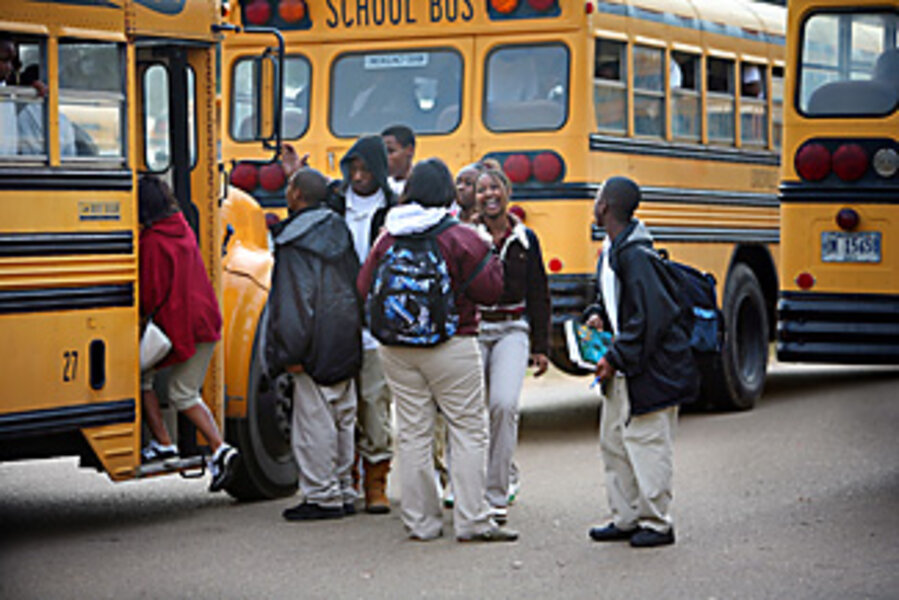Resegregation of U.S. schools deepening
Loading...
| Chicago
At one time, the Charlotte-Mecklenburg School District in North Carolina was a model of court-ordered integration.
Today, nearly a decade after a court struck down its racial-balancing busing program, the school district is moving in the opposite direction. About half of its elementary schools have 10 percent or fewer white students or 10 percent or fewer African-American students. [Editor's note: The original version overstated the number of segregated schools.]
"Charlotte is rapidly resegregating," says Carol Sawyer, a parent and member of the Charlotte-Mecklenburg Schools Equity Committee.
It's a trend that is occurring around the country and is even more pronounced than expected in the wake of court cases dismantling both mandated and voluntary integration programs, a new report says. The most segregated schools, according to the report, which documents desegregation trends, are in big cities of the Northeast and Midwest. The South and West – and rural areas and small towns generally – offer minority students a bit more diversity.
Suburbs of large cities, meanwhile, are becoming the new frontier: areas to which many minorities are moving.
These places still have a chance to remain diverse communities but are showing signs of replicating the segregation patterns of the cities themselves.
"It's getting to the point of almost absolute segregation in the worst of the segregated cities – within one or two percentage points of what the Old South used to be like," says Gary Orfield, codirector of the Civil Rights Project and one of the study's authors. "The biggest metro areas are the epicenters of segregation. It's getting worse for both blacks and Latinos, and nothing is being done about it."
About one-sixth of black students and one-ninth of Latino students attend what Mr. Orfield calls "apartheid schools," at least 99 percent minority. In big cities, black and Latino students are nearly twice as likely to attend such schools. Some two-thirds of black and Latino students in big cities attend schools with less than 10 percent white students; in rural areas, about one-seventh of black and Latino students do. Although the South was the region that originally integrated the most successfully, it's beginning to resegregate, as in the Charlotte-Mecklenburg district.
While resegregation has been taking place for some time, Orfield says the latest numbers are worrisome both for the degree to which they show the trend is occurring and in light of the US Supreme Court's most recent decision on the issue last June, which struck down several voluntary integration programs and made it more difficult for districts that want to work at desegregating schools to do so.
"If you [as a district] are going to ask your lawyer what's the easiest thing to do, it's to just stop trying to do anything," Orfield explains. "That's a recipe for real segregation."
Not everyone feels that way. Some groups applauded the Supreme Court's decision last summer as another step toward taking race out of school admission policies and allowing parents to send their kids to the schools most convenient for them. If schools start reflecting neighborhood makeup – which often means nearly all-white or all-minority – that doesn't have to matter, they say.
"Segregation means people are being deliberately assigned to schools based on skin color," says Roger Clegg, president of the Center for Equal Opportunity in Falls Church, Va. "If it simply reflects neighborhoods, then it's not segregation."
Mr. Clegg questions some of the resegregation research, noting that the percentage of white students in schools is often going down simply because they're a decreasing portion of the population. He also quibbles with the notion that an all-black, all-Hispanic, or all-white school is necessarily a bad thing.
"I don't think that the education that you get hinges on the color of the person sitting next to you in the classroom," Clegg says. "What educators should focus on is improving schools."
That sounds great in theory, say some experts, but the fact is that segregated schools tend to be highly correlated with such things as school performance and the ability to attract teachers.
"Once you separate kids spacially from more privileged kids, they tend to not get the same things," says Amy Stuart Wells, an education professor at Columbia University's Teachers College in New York. "And we need to start thinking about how a school that's racially isolated can be preparing students for this global society we live in."
Still, many of the programs that worked to achieve integration – such as busing – have been highly unpopular over the years. And in big cities, real integration is often virtually impossible: Many cities have largely minority populations, and the districts don't extend to the suburbs.
Suburbs, though, offer potential. The Civil Rights Project report noted that big-city suburbs educate 7.9 million white students along with 2.1 million blacks and 2.9 million Latinos. "This is the new frontier for thinking about how to make diverse schools work," says Professor Wells.
But so far, the data for suburbs are not encouraging, showing emerging segregation. Some integration advocates say this shows a need for more diversity training for teachers and students and for policies that encourage integrated housing, not just schools.
"Each affects the other," says Erica Frankenberg, the co-author on the Civil Rights Project study. "Unless we think about this jointly, we're probably not going to be able to create stable racial integrated neighborhoods and schools."





